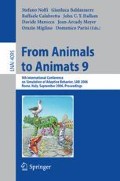Abstract
We study the role of the agent interaction topology in distributed language learning. In particular, we utilize the replicator- mutator framework of language evolution for the creation of an emergent agent interaction topology that leads to quick convergence. In our system, it is the links between agents that are treated as the units of selection and replication, rather than the languages themselves. We use the Noisy Preferential Attachment algorithm, which is a special case of the replicator-mutator process, for generating the topology. The advantage of the NPA algorithm is that, in the short-term, it produces a scale-free interaction network, which is helpful for rapid exploration of the space of languages present in the population. A change of parameter settings then ensures convergence because it guarantees the emergence of a single dominant node which is chosen as teacher almost always.
Access this chapter
Tax calculation will be finalised at checkout
Purchases are for personal use only
Preview
Unable to display preview. Download preview PDF.
References
Steels, L.: The evolution of communication systems by adaptive agents. In: Alonso, E., Kudenko, D., Kazakov, D. (eds.) AAMAS 2000 and AAMAS 2002. LNCS (LNAI), vol. 2636, pp. 125–140. Springer, Heidelberg (2003)
Smith, K., Kirby, S., Brighton, H.: Iterated learning: A framework for the emergence of language. Artificial Life 9(4), 371–386 (2003)
Batali, J.: Computational Simulations of the Emergence of Grammar. In: Approaches to the Evolution of Language: Social and Cognitive Bases. Cambridge University Press, Cambridge (1998)
Nowak, M.A., Komarova, N.L.: Towards an evolutionary theory of language. Trends in Cognitive Sciences 5(11), 288–295 (2001)
Komarova, N.L.: Replicator-mutator equation, universality property and population dynamics of learning. Journal of Theoretical Biology 230, 227–239 (2004)
Nowak, M.A., Plotkin, J.B., Jansen, V.A.A.: The evolution of syntactic commmunication. Nature 404, 495–498 (2000)
Komarova, N., Niyogi, P., Nowak, M.: Evolutionary dynamics of grammar acquisition. Journal of Theoretical Biology 209(1), 43–59 (2002)
Lee, Y., Collier, T.C., Taylor, C.E., Stabler, E.E.: The role of population structure in language evolution. In: Proceedings of the 10th International Symposium on Artificial Life and Robotics (2005)
Dall’Asta, L., Baronchelli, A., Barrat, A., Loreto, V.: Agreement dynamics on small-world networks. Europhysics Letters (2006)
Steels, L.: A self-organizing spatial vocabulary. Artificial Life 2(3), 319–332 (1996)
Lieberman, E., Hauert, C., Nowak, M.A.: Evolutionary dynamics on graphs. Nature 433, 312–316 (2005)
Mitchener, W.G.: Bifurcation analysis of the fully symmetric language dynamical equation. Journal of Mathematical Biology 46(3), 265–285 (2003)
Barabási, A.L., Albert, R.: Emergence of scaling in random networks. Science 286, 509–512 (1999)
Albert, R., Barabási, A.L.: Topology of evolving networks: Local events and universality. Physical Review Letters 85(24), 5234–5237 (2000)
Chung, F., Handjani, S., Jungreis, D.: Generalizations of Polya’s urn problem. Annals of Combinatorics 7, 141–153 (2003)
Swarup, S., Gasser, L.: Unifying network and evolutionary dynamics (in preparation, 2006)
Author information
Authors and Affiliations
Editor information
Editors and Affiliations
Rights and permissions
Copyright information
© 2006 Springer-Verlag Berlin Heidelberg
About this paper
Cite this paper
Swarup, S., Gasser, L. (2006). Noisy Preferential Attachment and Language Evolution. In: Nolfi, S., et al. From Animals to Animats 9. SAB 2006. Lecture Notes in Computer Science(), vol 4095. Springer, Berlin, Heidelberg. https://doi.org/10.1007/11840541_63
Download citation
DOI: https://doi.org/10.1007/11840541_63
Publisher Name: Springer, Berlin, Heidelberg
Print ISBN: 978-3-540-38608-7
Online ISBN: 978-3-540-38615-5
eBook Packages: Computer ScienceComputer Science (R0)

